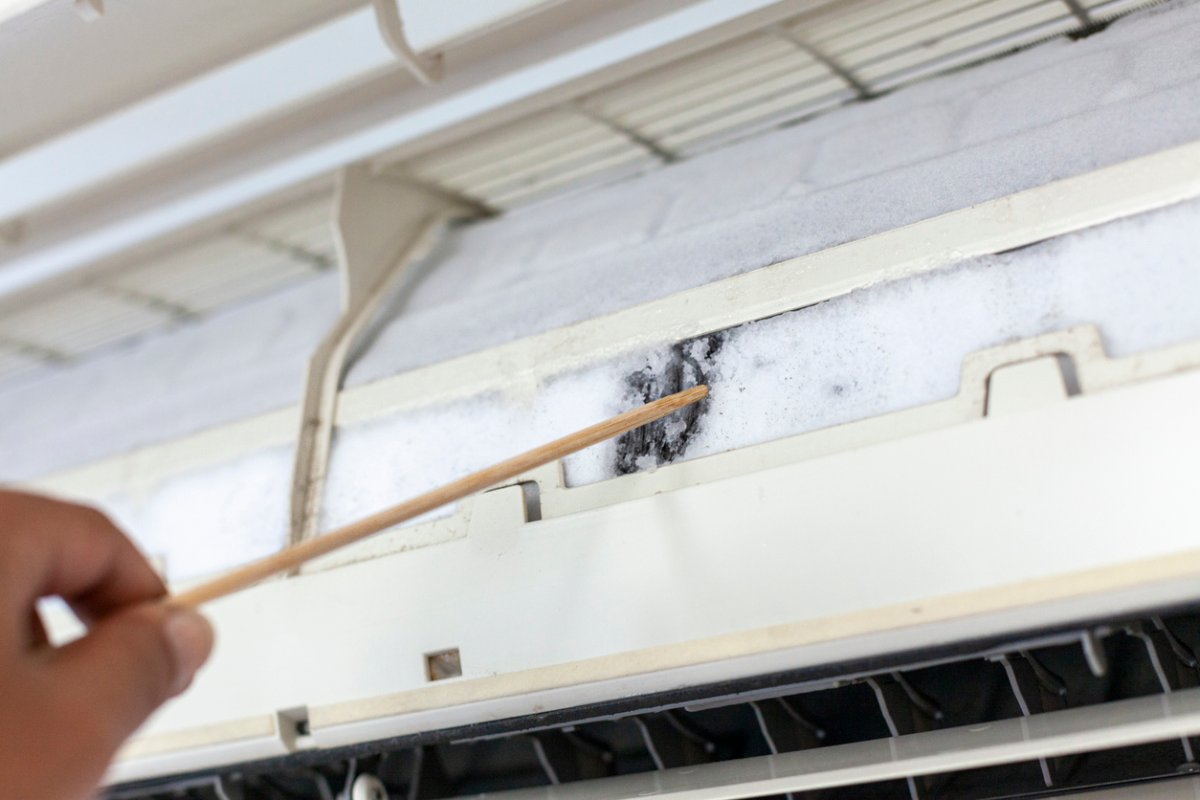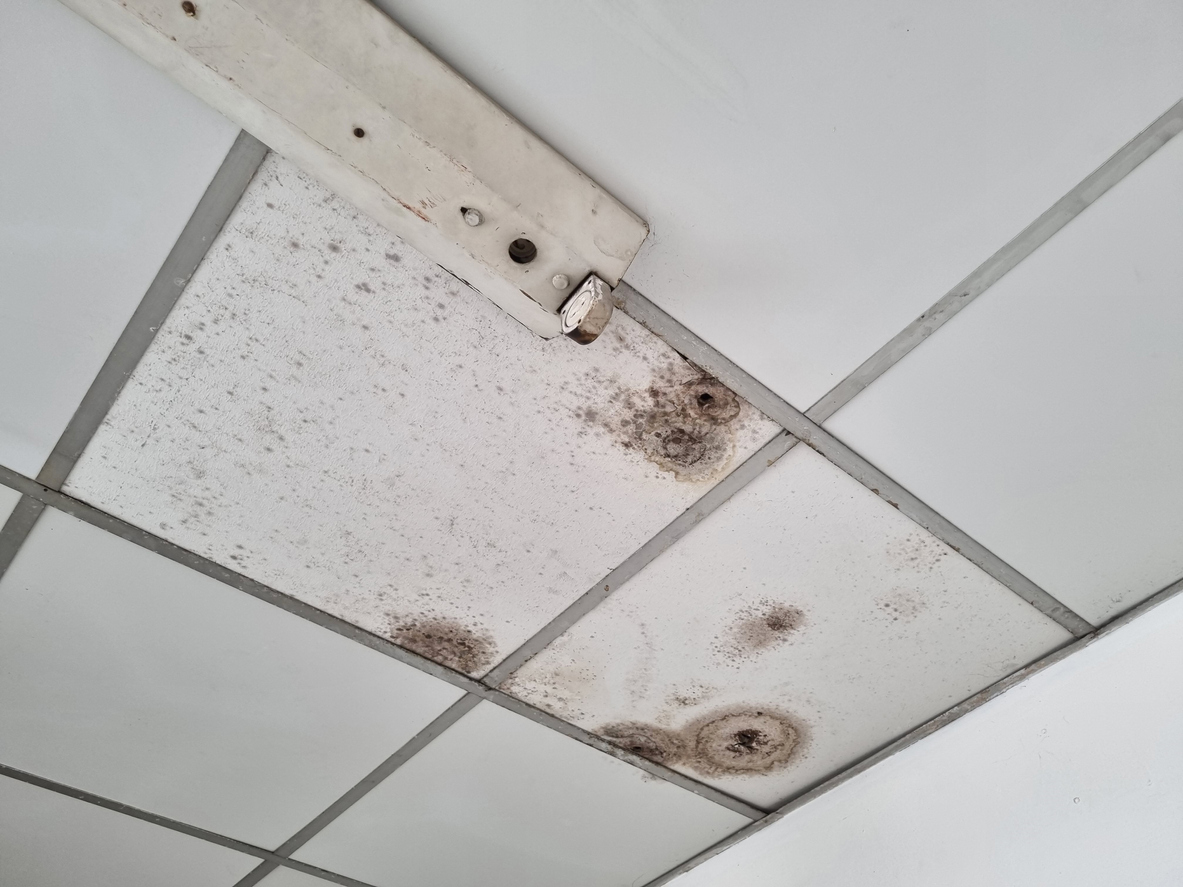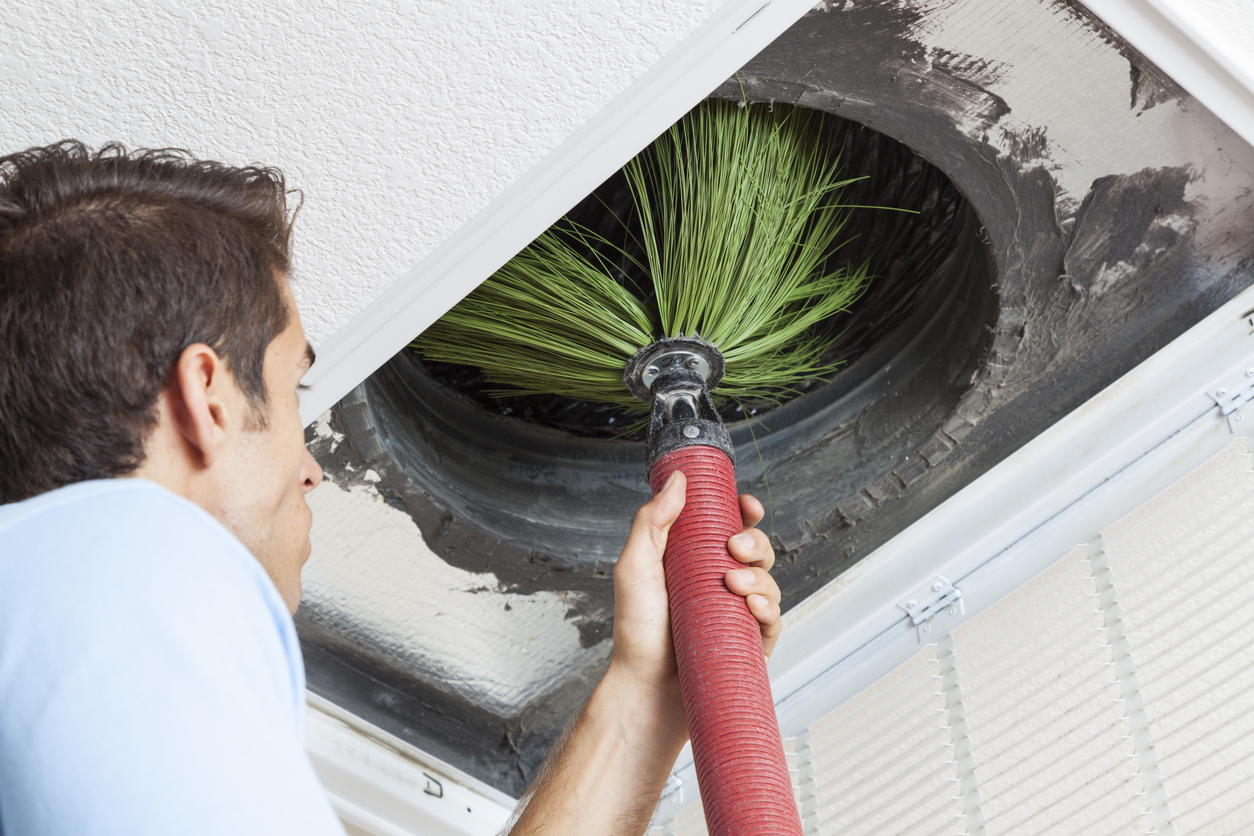

We may earn revenue from the products available on this page and participate in affiliate programs. Learn More ›
Q: Each time my air conditioning kicks on, I notice a musty smell inside my house. I also noticed dark spores around a few of my vent covers. Are these signs of black mold in my air vents or house? If so, how do I get rid of it for good?
A: Black mold in air vents can be particularly insidious because, unlike mold on walls or ceilings, it occurs mostly out of sight. But just because homeowners can’t see this mold does not mean it isn’t having a negative effect on their health. Since air duct mold can expose residents to harmful spores, it’s important to put a stop to this issue as soon as possible.
A musty smell, visible spores around air vents, and allergy-like symptoms are usually some of the first signs of toxic black mold growing in a home’s air vents, but it may be necessary to call a duct cleaner or mold inspector for confirmation. Find out more about the signs of black mold in air vents and what next steps to take to get rid of it for good.
Causes of Black Mold in Air Vents
Moisture buildup is common in air conditioning and HVAC systems, which often leads to black mold showing up in air vents. According to Tony Abate, a certified mold inspector and vice president and chief technology officer at AtmosAir Solutions in Fairfield, Connecticut, “Black mold growth occurs when moisture and various surfaces meet, and the mold can grow and spread. Air ducts can build up with dust and spores, and over time, especially if there is higher humidity in the air, mold can build up in the ducts. This can especially happen to internally lined ducts and ducts made of fiberglass or other porous materials.” Moisture buildup in air vents can have a variety of causes, including:
- High humidity levels
- Leaks from plumbing, roofs, or windows
- Flooding
- Excess condensation
- Poor ventilation
- Ductwork issues
Consistently monitoring a home’s heating and air conditioning systems or having them inspected at least once a year by one of the best HVAC companies (such as Aire Serv) can greatly reduce the likelihood of moisture buildup that leads to mold growth. Regular maintenance and early detection of issues can also make for a much more efficient HVAC system that’s less likely to foster mold growth.
Signs of Black Mold in Air Vents
Most of the time, air vents are out of sight and out of mind, meaning a black mold problem can go undetected for quite a while. It’s important to keep an eye out for some signs of black mold in air vents before the problem gets out of hand.
A strong musty smell is one of the first detectable signs of black mold growth in a home’s air vents.
Mold produces volatile organic compounds (VOCs) as it grows, and these compounds are where the recognizable smell of mold comes from. This odor is often described as “musty” or “earthy” and is typically one of the first signs of mold in a house. One way to identify black mold in particular is by its distinct smell, which is often compared to rotting leaves. Mold in the air vents will smell especially strong whenever the HVAC kicks on, spreading throughout the entire home. Once it’s clear that there is a musty smell coming from the ducts, the next step is to see if any visible signs of mold growth are present.

Visible spores around vent covers and the surrounding walls are another indication that mold is growing within air ducts.
One of the other early signs of mold in the house is visible spores. “Generally, you will see black staining or those black dots commonly found where mold growth is present,” Abate says. If there is mold in the air vents, these spores will be located around the vent covers or on the walls or ceiling surrounding the vent. What black mold looks like can vary greatly depending on its location and the environment where it is growing, and it may be black, green, brown, or even yellow. For this reason, the only way to confirm its presence is to learn how to test for black mold or find out who to call for a mold inspection.
It’s also a good idea to check the furniture and flooring beneath the vents for mold spots since the air flowing out of the vents can loosen the spores and push them out onto other surfaces. Surface mold can be treated with the best mold removers that can be treated with the best mold removers, which homeowners can purchase at home improvement stores, but the larger issue at play also needs to be examined or treated by a professional.
Residents may also notice black mold exposure symptoms such as sneezing, congestion, and itchy eyes.
Black mold in air vents is harmful not only to the HVAC system but also to those who are exposed to it. “Mold spores have been linked to many negative health effects like allergic symptoms, respiratory distress, itchy burning eyes, sore throats, and in extreme cases, long- and short-term memory loss,” says Abate. “The common black molds such as Aspergillus and Stachybotrys are linked to many of these negative effects.” The Cleveland Clinic also lists sneezing, coughing, and congestion as common black mold exposure symptoms.
These symptoms, sometimes referred to as “mold toxicity,” can affect anyone who comes into contact with mold, not just those who are allergic. Unfortunately, once spores are released into the air, they can stay there for an indefinite amount of time. This is why it’s generally not safe to run an air conditioning unit that has been affected by black mold. Those who are concerned about mold exposure affecting their health will want to consult a doctor or health care professional.
Those with respiratory conditions or weakened immune systems may experience more severe reactions, such as asthma attacks or difficulty breathing.
The inhalation of mold spores can lead to serious health issues, especially for people with existing respiratory conditions or a history of allergies. For those who suffer from asthma in particular, breathing in black mold can lead to wheezing, shortness of breath, dry cough, or chest tightness. There are ways to treat symptoms or improve air quality through air purifiers or other measures, but ultimately the underlying cause of mold growth will need to be addressed. Plus, it’s not recommended for those with underlying conditions to treat mold themselves since they will risk exposure to mold spores as well as fumes from strong chemicals that aren’t safe if inhaled.

What to Do About Black Mold in Air Vents
Black mold in air vents will need to be dealt with urgently as it is a health hazard and can also damage the home’s HVAC system and lead to mold growth in other parts of the home. Fortunately, there are a variety of professionals who can eliminate this problem for good.
Homeowners who notice any signs of black mold in their air vents may want to schedule an appointment with an air duct cleaning company.
The best air duct cleaning companies (such as Ductz or Stanley Steemer) have the expertise and equipment to thoroughly clean ducts and vents. They can therefore remove not only dust and debris but also mold. This can help eliminate the source of the mold and improve indoor air quality so that those living in the home won’t be exposed to any harmful toxins. Abate adds that “generally air duct cleaning is recommended at least every 5 years, but in a space where mold growth has happened, cleaning yearly would be a good choice.”
During the cleaning process, professionals can also identify any issues contributing to mold in the HVAC, such as leaks, poor insulation, or inadequate ventilation. Addressing these issues will help prevent future mold problems and provide peace of mind about the quality of the home’s indoor air. Abate recommends that those who do hire an air duct mold removal company look for one that is a member of NADCA, the National Air Duct Cleaners Association. He goes on to say that “air cleaning technology like bipolar air ionization will saturate the ducts with beneficial ions that can help to sanitize the ducts and reduce mold growth and deliver purified air to occupants.”
A mold remediation service can take care of any mold growth that has spread beyond air vents to the rest of the home.
Black mold spores in air vents can be dispersed to the rest of the home anytime the system turns on. If these spores land in a place where conditions are favorable to mold, they will begin to grow and spread. For this reason, it’s a good idea to have one of the best mold removal companies (such as ServiceMaster Restore or ServPro) inspect the home if there has previously been mold in the air conditioner. In most cases, a mold inspection costs between $299 and $1,014.
After the inspection, technicians will be able to tell how major or minor the mold growth is and also what type of mold is present.
They’ll also be able to provide a quote for mold remediation costs, which are typically between $1,125 and $3,439. While this price may seem steep, homeowners will want to let a professional eliminate the problem rather than attempting to do it themselves. According to Abate, “Remediating mold must be done with precision, as containing the space during the cleanup is critical or else the problem can be spread to other areas and actually become worse.” Professional mold removal services will likely use specialized equipment such as fans and mold detectors, as well as formulated solutions for mold treatment that can help prevent any growth from occurring in the future.
